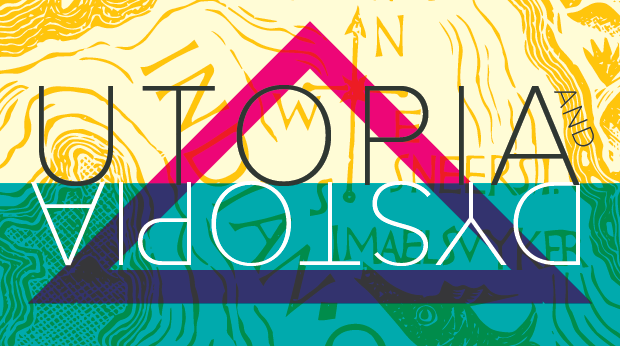You have no items in your cart. Want to get some nice things?
Go shopping
Marking the 500th anniversary of the publication of Thomas More’s Utopia, this exhibition extensively charts visions of the perfect society.
Based on the Senate House’s collection, most of the display is textual – predominantly narrative fictions – although it also contains some real life utopian experiments. These include the attempt at communal living in 1841 at Brook Farm (near Boston in Massachusetts), which was based on the belief in the inherent goodness of all people. Also on display is Ebenezer Howard’s design for a garden city, a vision of towns surrounded by greenery and separated from industry. While these movements tended to be short lived – a fire brought about the demise of Brook Farm a mere six years after its’ founding – their principles often have a more significant legacy. Howard’s model, for example, would go on to have a pervasive influence on the development of the garden suburb and postwar town planning.
Retreat from industrialisation was a central impulse within the 19th century, achieving notable expression in William Morris’s dream of a rural idyll in News from Nowhere (1890), where regeneration is brought by a return to the past. The narrator falls asleep and awakens to a future in which the inhabitants of England have decided to return to a pre-industrial culture in which cities have been destroyed along with the railway system. Journeying across London and up the Thames, he perceives how the new order is one of harmonious, egalitarian bliss. Morris’s work posits that the restructuring of society can bring about radical alterations in the human disposition; the abolition of the legal system and the penal code has led people to feel remorse for their actions, and as a result, there is no longer any crime.
Resistance to such idealism was central to the development of HG Wells’s technocratic utopianism. Despite his initial admiration of Morris in the mid-1880s, Wells’s rejection of Morris’s vision became increasingly apparent towards the end of the century. The Time Machine (1895) contains a notable strain of satire of Morris’s “epoch of rest”. The time traveller journeys through the Thames valley of the future, excited at the prospect of finding an ideal society. However, the inhabitants that he encounters are indolent, frail and childlike – the degenerate specimens of a decayed humanity that exists only as dinner for the bestial Morlocks. The timetraveller speculates that the cause of decline might have been the result some sort of static utopia that has rendered unnecessary any mental or physical exertion.
Wells’s rejection of Morris is stated more overtly at the start of his most comprehensively expressed utopian vision, A Modern Utopia (1905), where he dismisses its impracticality: “Were we free to have our untrammelled desire, I suppose we should follow Morris to his Nowhere, we should change the nature of man and the nature of things together… wave our hands to a splendid anarchy.” He goes on to emphasise that the nature of his proposal is on “a more practical plane”. Wells’s work presents a world subject to hierarchical rule by a governing scientific elite, itself assisted by a card index that contains detailed information about every inhabitant of the world.
One of the significant features of many of the utopic and dystopic schemes of the 20th century is their interreferentiality: time and again, the rejection of one author’s vision provides fuel for the formation of another. Dissatisfaction with Wells’s optimism in the capacity of science to bring happiness was crucial for the development of Aldous Huxley’s dystopia of a scientifically planned society in Brave New World (1931). Huxley later confided to a friend that he started writing Brave New World to have “a little fun pulling the leg of H.G. Wells” (Wells for his part would denounce Brave New World as that “Bible of the impotent genteel”). These technologies have rendered a populace of mindless automata living for the thrills of drugs, mass culture and transient sexual relationships.
Despite the clearly dystopic elements, one of the key debates in Huxley scholarship is the degree to which his vision could in fact be read as a plan for social reform. Many facets of the Brave New World’s society are positive: there is an absence of pain and disease; the lack of close family ties (natural childbirth is viewed as a disgusting perversion) means that death brings no mourning; all members of society are employed and have their material wants satisfied. Reproduction occurs within the laboratory under eugenicist principles – according to which intellectual capabilities are kept under strict control, a position that Huxley’s writings contemporaneous to the novel’s composition suggest his endorsement.
In an article, “Are We Growing Stupider?” (1932), Huxley advocated eugenics as a way of increasing levels of intelligence, proposing that the government should give incentives to encourage the fit to have more children. Rather more starkly in his later essay “What is Happening to Our Population?” (1934), he threatened that in two hundred years “a quarter of the population of these islands will consist of half-wits” and advocated the sterilization of “sub-normal stocks”. Aspects of his Brave New World would also surface in his later utopian novel Island (1962), which also features drug use (“the truth and beauty pill”), sexual promiscuity and a scepticism of family ties. Although the Palenese still have childbirth, every child has a Mutual Adoption Club which enables them to leave the confines of their own family.
The boundaries between the dystopian and utopian are typically insecure. Both tend to use the same narrative device of extrapolating from present trends, usually with the same didactic ends: imagining an alternative vision of society either to frighten the reader to avoid such as possibility or enjoin them to bring it about. There is, moreover, structurally something fundamentally problematic within the fictionalisation of utopias given narrative need for tension or conflict to have some form of drive. Its utopic or dystopic quality can often be seen as a matter of perspective – brought into sharp relief in the climactic showdown between John the Savage and Mustapha Mond at the end of Brave New World. When Mond extols New World comfort, the savage defiantly exclaims: “But I don’t want comfort. I want God, I want poetry, I want freedom, I want goodness. I want sin… I’m claiming the right to be unhappy.”
Utopia and Dystopia continues at Senate House Library until December 17 2016. Entry is free. See the Senate House Library website for more information about the exhibition and the wider programme of public engagement events for Utopia 2016.

About Imogen Woodberry
Imogen Woodberry is an AHRC-funded PhD student at the Royal College of Art. She is an assistant editor at Review 31.




